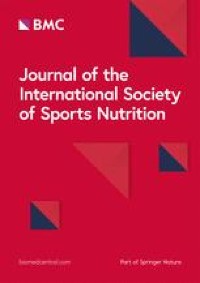Study design and subjects
In the present study we have retrospectively analysed routine data collected between January 2012 and December 2019 in elite athletes defined as those who have previously competed as regional and/or national players [27].
Subjects were selected for this study according to the following inclusion criteria: (1) both sexes, (2) age between 18 and 45 yrs and (3) at least 24 h/week of training. Subjects affected by overt metabolic and/or endocrine diseases and/or regularly taking any medications or using any drugs affecting energy metabolism, were excluded. This study was conducted in accordance with the Declaration of Helsinki and was approved by the Federico II University Ethical Committee.
All measurements were performed early in the morning (8.30 a.m.) after an overnight fast (10–12 h) according to standardized conditions, i.e. abstention from alcohol, caffeine or other thermogenetic substances, smoking and any physical activity for 24 h (in most cases 36 h) prior to the assessment.
Anthropometry and bioelectrical impedance analysis
Body weight was measured in duplicate to the nearest 0.1 kg using a platform beam scale and stature was measured in triplicate to the nearest 0.5 cm using a stadiometer (Seca 709; Seca Hamburg, Germany). The subject wore light clothes and no shoes. Body mass index (BMI) was calculated as body weight (kg) divided by squared stature (m2).
BIA was performed by phase-sensitive device (Human IM Touch, DS Medica S.r.l., Milan, Italy). Measurements were carried out with empty bladder, in a supine position for at least 10 min before starting the measurement). After cleaning skin surface, patients were asked to lay with upper and lower limbs slightly abducted, so there was no contact between the extremities and trunk. The measuring electrodes were placed on the anterior surface of the wrists and ankles, and the injecting electrodes were placed on the dorsal surface of the hands and the feet, respectively (overall, eight electrodes). Data for impedance and PhA from the non-dominant side of the body, measured at 50 kHz, were considered. BI-index was calculated as the ratio stature2/resistance (cm2/ohm).
Before each test the analyser was calibrated with the calibration considered successful if resistance value was between 382 and 385 Ω and reactance was 44–46 Ω, as indicated by the manufacturer guidelines. The test-retest coefficient of variation (CV) (as determined in ten subjects) was always less than 3%.
Resting energy expenditure
REE was measured (MREE) by indirect calorimetry [28] using a canopy system (Vmax® Encore system, CareFusion Corporation, U.S.). The instrument was routinely checked by burning ethanol, whereas oxygen and carbon dioxide analysers were calibrated on the test day using nitrogen and standardized gases (mixtures of nitrogen, carbon dioxide and oxygen).
Measurement conditions for by indirect calorimetry were defined following the suggestions made by Compher et al. [29] and Fullmer et al. [30]. In addition to the standardized conditions already mentioned, REE was measured with the subject laying down, but awake, on a bed in a quiet environment. After a 15-min adaptation period, oxygen consumption and carbon dioxide production were measured for 45 min. Only steady state periods of measurement were selected according to the procedures for the ventilated hood system (< 5% CV). The first 5 min were discarded. Also, the inter-day CV (as determined in 10 subjects on subsequent days) was always less than 4%. The flow throughout the canopy was modified in order to maintain the CO2 between 0.6–0.8%.
Energy expenditure was calculated using the abbreviated Weir’s formula, neglecting protein oxidation [31]. Data were excluded from analysis if the respiratory quotient was outside the expected range (0.71–1.00) and when measured REE was ±3 standard deviations outside the mean REE.
Predictive equations
In the validation group REE was predicted (PREE) using five equations that are widely mentioned with respect to the general population (Harris & Benedict [7], Schofield [8], FAO/WHO/UNU [9], Mifflin [10] and Owen [11]), and three athletes-specific formulas from the literature (De Lorenzo [15], Wong [16] and ten Haaf [17])(Table 1).
Statistical analysis
Statistical analyses were performed using IBM SPSS (version 26). All data are presented as mean ± standard deviation (SD), unless otherwise specified, and significance was defined as p < 0.05. The Kolmogorov-Smirnov Test and the Shapiro-Wilk Test were used to assess if variables were normally distributed.
As presented in Table 2, subjects were randomly assigned to either a calibration or a validation group.
As far as statistical power is concerned, in the calibration group for alpha level = 0.05 and beta = 0.20 a sample size of 75 subjects is requested to reach a p < 0.05 for r = 0.330 (R2 = 0.10). In the validation group a sample size of 51 subjects is adequate to identify a significant between-groups difference of 50 kcal with a standard deviation of 125 kcal.
Linear correlation was applied for evaluating associations between variables. Multivariate linear regression analysis was performed to develop the new predictive equations, with REE measured by indirect calorimetry as dependent variable. We generated models as follows: in Model 1, age, sex, weight, stature and BMI were set as predictors, while in Model 2 we added the raw BIA variables (BI-index and PhA). Coefficient of determination (R2) and standard error of the estimate (SEE) were considered for assessing the predictive power of formulas. The regression equations, derived from the calibration subset, were applied to the validation group.
Differences between PREE and MREE as well as bias, i.e. the mean percent difference, were both used as a measure of accuracy at the population level. Bias was found acceptable if within ±5% [32, 33]. The percentage of patients with a PREE within 90–110% of MREE was used as a measure of accuracy at the individual level (precision accuracy). Values lower than 90% were classified as underprediction, while values higher than 110% as overprediction. The root mean squared error (RMSE) was used to define the predictions obtained with these models. Finally, comparisons of PREE-MREE differences vs mean PREE-MREE values were performed by Bland and Altman plots to estimate the limits of agreement [34].
Source link

